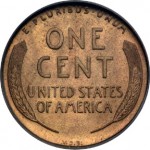If you want to find a mirror of a society’s ideal—the image of what it hopes and imagines itself to be—public sculpture is as good a place as any to start, and none is more common or readily available than the public sculpture we carry around with us on the coins in our pockets.
This year will bring some changes to the world’s most common public sculpture, the Lincoln penny. The occasion is the Lincoln bicentennial, and the Mint is happy. Collectors and speculators were glad to pay $8.95 for the two-roll sets of the new coins (worth $1.00) that went on sale on February 12, 2009 and sold out within a month. And so far few have complained about the new reverse design, which represents the Kentucky log cabin at the Abraham Lincoln Birthplace National Historic Site. (Of course, that cabin is itself a representation of someone’s idea of the original structure.)
Three more designs, one to be issued every three months throughout the year, will represent respectively Lincoln’s education, his pre-Presidential careers as lawyer and politician, and his Presidency. In 2010 and beyond, the Mint will issue yet another reverse, “emblematic of President Lincoln’s preservation of the United States of America as a single and united country.” So there will be five new designs, each issued by the mints at Philadelphia, Denver, and San Francisco (each mint’s coins has a special mint mark, P, D, and S, respectively), creating fifteen new coins for the delectation of collectors within less than thirteen months.
The original Lincoln cent, designed by Victor David Brenner, reflected the genius of the sculptor and of President Theodore Roosevelt, himself an aesthete, who forced change on the Mint bureaucracy of his day because he found the coinage of the United States unworthy of a great republic. It still is. For the most part, the heroes on our coinage and paper money depict the men considered great half a century ago.
Surely John F. Kennedy’s reputation has undergone re-evaluation since he replaced Benjamin Franklin on the half-dollar in a moment of national grief. Walt Whitman, George Gershwin, George S. Kaufman, Jonas Salk, Earl Warren, Eleanor Roosevelt, Ronald Reagan, Sojourner Truth—from the arts and sciences alone the list of possible alternatives to the present set of political icons on our coins and currency (which date from the New Deal or before) is almost limitless.
All this brings to mind something I thought about while emptying my pockets the other day.
At some time in the last century, I was taken to a Broadway revival of the musical comedy “1776.” In one scene, an actor named Paul Michael Valley, who played Thomas Jefferson, briefly stood in profile, silhouetted against an open door. Some suburban housewife in the next row murmured to her neighbor, “He looks just like the guy on the nickel.” Indeed, he did, which may explain his casting.
Anyway, while putting my pocket change on the dresser, I noticed one of those odd nickels struck by the Mint to commemorate the bicentennials of the Louisiana Purchase and the Lewis and Clark Expedition. The obverse looked like the Man in the Moon. Of course, the head was still old Tom’s, but the image had changed.
The Purchase itself was commemorated in 2004 by adapting the design of Jefferson’s Indian Peace Medal for the reverse of the five cent piece. The Indian Peace Medals, a British tradition continued after Independence, were large, attractive silver medals awarded by the United States to Indian chiefs or other important men on such occasions as major conferences or the signing of treaties. Intriguingly, this custom reflected the European tradition of exchanging decorations at historic moments of concord, which the United States has otherwise never adopted.
In place of the King appeared the current President, and on the reverse, in Jefferson’s case, appeared two clasped hands, the one to the right with a metal wristband such as frequently worn by Indian chiefs, and the one to the left with an army officer’s braided cuff, all beneath a crossed hatchet and inverted peace pipe. The medal also bore the words, “Peace and Friendship.”
Many of Jefferson’s medals were given to Indians during Lewis and Clark’s expedition from St. Louis to the Pacific Coast between 1804 and 1806. They are mentioned in the Expedition’s Journal as among the articles taken for presentation to the Indians. On August 1, 1804, the Journal records the gift of a “First Grade” medal and flag to a “Grand Chief,” medals of the Second Grade to lesser chiefs; and of the Third Grade to inferior chiefs. Certificates to accompany the medals were also issued, such as one surviving in a California collection which refers to “the special confidence reposed by us in the sincere and unalterable attachment of War Charpa the Sticker, a Warrior of the Soues Nation, to the United States…”
Later in 2004, the Mint issued yet another kind of nickel with a reverse featuring one of the Expedition’s flatboats, driven by both sail and poles, like a Mediterranean war galley.
In the spring of 2005, the year of the coin I found in change, the Mint had doubly changed the coin. The obverse had Jefferson’s profile, oddly presented as to leave the coin resembling the Man in the Moon, with the word “Liberty” in Jefferson’s handwriting. The reverse adapted one of the Mint’s most popular designs, James Earl Fraser’s Buffalo nickel of 1913-1938, for the next coin in the series. Over 1.2 billion Buffalo nickels were struck during that quarter-century. They have now vanished from circulation. But as late as the 1960s, one still found Buffalo nickels in change, with the stern profile of an austere Indian warrior on the obverse and the massive buffalo on the reverse.
Fraser’s visual economy in its design is profoundly moving: without a touch of sentimentality, few accessible works of art so powerfully visualize the nobility of tragedy. And his commanding, virile bison dominates the design of its coin.
But as is often the case in the Mint’s modern adaptations of older designs from a heroic past, the modern buffalo, despite its unequivocal masculinity, lacks confidence. It seems neutered, almost cringing, standing, somehow off-balance, on a small, sloping patch of prairie, fenced in by the words “United States of America.”
In the fall and winter of 2005, the coin was changed yet again: the Man in the Moon obverse was coupled with a new reverse, a view of the Pacific Ocean with a quote from Captain Clark: “Ocean in view! O! the joy!” The minor irritant here is that Clark, whose writings betray a libertarian, if not Shakespearean, attitude toward standardized spelling, had written “Ocian.” While the Oxford English Dictionary includes “ocian” among its citations, the Mint corrected Clark’s usage. According to CNN, when questioned about this, a Mint spokeswoman answered, “We didn’t want to confuse anyone into thinking we couldn’t spell.” Again, a lack of confidence, this time in the reality of Clark’s spelling.
The following year showed the most unusual change in the design. Even as Monticello returned to the reverse, the obverse had Jefferson gazing at the viewer in one of American coinage’s first full-face designs. This is unusual for a technical reason. Coins first show signs of wear on the highest point of the design. The traditional profile tends to wear gracefully. But a full face design tends to wear out nose first.
The most notorious example of this was Copper Nose coinage of England’s King Henry VIII. By the 1540s, Henry was running out of money due to his personal and public extravagance. He both raised taxes and debased the coinage, transforming the nominally silver shilling to a copper coin which was dipped into a silver nitrate solution. Electrolysis left a thin wash of silver on the coins.
Instead of a conventional profile, the new coins bore the King’s facing image, executed with surprising candor, bearded and repellently bloated. Even a little wear on the coin’s highest relief – which with a facing portrait is the nose – revealed its copper core. As the coating wore off the most prominent feature – Henry’s nose – it became reddish brown. Hence, the king acquired the nickname “Old Coppernose.”
Such a sobriquet is unlikely to be attached to Jefferson, who is, after all, nearly two centuries dead. His coin is silver-colored metal all through. But the full face design is off-putting and unattractive, and one hopes the Mint will return to the customary usage in its future coinage.
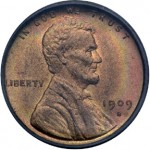
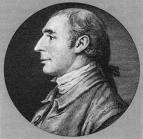 In 1782, Gouverneur Morris wrote a report describing the “perplexing…and troublesome” exchange rates among state currencies. He suggested a federal mint and a national coinage that would reconcile the different state currencies with an extremely complicated system involving a common denominator of 1,440 units.
In 1782, Gouverneur Morris wrote a report describing the “perplexing…and troublesome” exchange rates among state currencies. He suggested a federal mint and a national coinage that would reconcile the different state currencies with an extremely complicated system involving a common denominator of 1,440 units.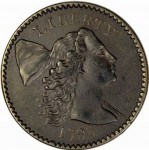

 the designer, James Longacre, apparently popped an Indian headdress on his pretty daughter Sara. But charming Sara was merely a model for an allegory. Placing an historical person on a coin was seen as monarchical and inappropriate for a republic. This suited the Mint bureaucracy, who seemed more concerned about whether their coins would stack for easy counting than their physical beauty.
the designer, James Longacre, apparently popped an Indian headdress on his pretty daughter Sara. But charming Sara was merely a model for an allegory. Placing an historical person on a coin was seen as monarchical and inappropriate for a republic. This suited the Mint bureaucracy, who seemed more concerned about whether their coins would stack for easy counting than their physical beauty.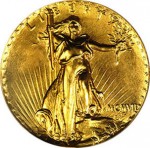 The sculptor and the statesman collaborated to make coins beautiful. Their triumph is Saint-Gaudens’ “Standing Liberty” twenty-dollar gold piece, first struck in 1907. On the obverse, a voluptuous Liberty holds aloft in her right hand the torch of Enlightenment and in her left the olive
The sculptor and the statesman collaborated to make coins beautiful. Their triumph is Saint-Gaudens’ “Standing Liberty” twenty-dollar gold piece, first struck in 1907. On the obverse, a voluptuous Liberty holds aloft in her right hand the torch of Enlightenment and in her left the olive 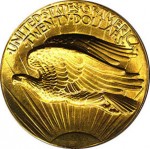 branch of peace. On the reverse, an eagle soars above a sun rising in glory. Saint-Gaudens died before he could design a new cent. Roosevelt had another artist for the job.
branch of peace. On the reverse, an eagle soars above a sun rising in glory. Saint-Gaudens died before he could design a new cent. Roosevelt had another artist for the job.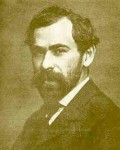 In 1908, Brenner was commissioned to create a bronze plaque for the centennial of Lincoln’s birth in 1909. Around the same time, the Panama Canal Commission also retained him to design a medal. Its obverse would bear President Roosevelt’s profile. T.R. posed at Brenner’s studio. The President openly admired the plaster patterns for the Lincoln plaque and later suggested to his secretary of the treasury that Brenner’s portrait of Lincoln should appear on a coin. Consequently, Brenner was the only person invited to participate in formulating the new design, much to the chagrin of Charles Barber.
In 1908, Brenner was commissioned to create a bronze plaque for the centennial of Lincoln’s birth in 1909. Around the same time, the Panama Canal Commission also retained him to design a medal. Its obverse would bear President Roosevelt’s profile. T.R. posed at Brenner’s studio. The President openly admired the plaster patterns for the Lincoln plaque and later suggested to his secretary of the treasury that Brenner’s portrait of Lincoln should appear on a coin. Consequently, Brenner was the only person invited to participate in formulating the new design, much to the chagrin of Charles Barber.